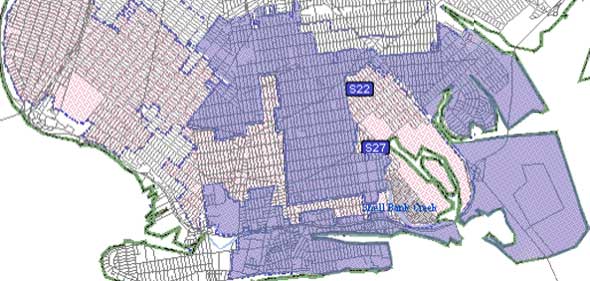Tomorrow: Political Redistricting Hearing – Make Your Voice Heard!

Redistricting of political boundaries occurs every 10 years – following the results of the U.S. Census – but it’s usually off the radar of most members of the community. This year, redistricting got a bit of a higher profile when Congressman Anthony Weiner resigned, leading to the now oft-spoken narrative that the winner of his seat is of minimal importance, as the most junior New York representative in federal politics will likely lose his job to redrawn lines and the elimination of a seat.
Well, that’s our seat they’re talking about, and redistricting stands to have profound implications on the way residents of Sheepshead Bay are represented.
New York’s 9th is likely to be divided up between several other districts, and the area around Sheepshead Bay – a constituency that’s leaning more Republican by the day – could be lobbed in with, say, Republican Michael Grimm of Staten Island, or Jerold Nadler, the representative who covers a huge chunk of the borough’s Orthodox Jewish community, and a swath of Manhattan. Depending on where you sit, it could mean your opinions get marginalized, so now’s the time to speak up and say who you want to throw your lot in with.
Of course, redistricting isn’t limited to the congressional districts; it affects the size and shape of districts for both federal and state government reps – and our area is severely warped at the state level.
This is why the Legislative Task Force on Demographic Research and Reapportionment (LATFOR) is holding hearings to involve New Yorkers in the process. The Brooklyn hearing is happening at Brooklyn Borough Hall, located at 209 Joralemon Street, tomorrow, Tuesday, September 20 at 10:00 a.m. If you wish to speak at the Brooklyn hearing or have any questions, please contact the Task Force at (212) 618-1100. For further information, please visit their website at www.latfor.state.ny.us.
For a roundup of issues to be considered by the task force – and what residents should be thinking about – Councilmember Jumaane Williams put out the following list for constituents:
Population Equality: Given “one person, one vote,” what maximum population deviation should be allowed for state assembly and senate districts (Congressional districts have ZERO deviation)? . Current ADs and SDs have a +/- 5%, overall 10% deviation. Good governmentt groups, Governor Cuomo and others are calling for 1% deviation. Large deviations permit political manipulation.
Contiguous Territory: Should districts consist of contiguous (connected) territory? Should districts be drawn with territory easily travelled from one end of the district to another? Should bodies of water be used to connect parts of districts?
Fair Representation of Minority Groups: New York State is now 42 % Black, Latino and Asian, but has nowhere near that percentage of state legislators or Congress members. How should legislative districts be drawn to provide minorities / “protected classes” an equal opportunity to elect the representatives of their choice in compliance with the US Constitution, the Voting Rights Act and US Supreme Court decisions?
Lack of Diversity on LATFOR: In New York, there are 3.1 million African-Americans, 1.5 million Asian-Americans and the state is 52% female, — but they have no voice on LATFOR, who draws the lines for their political representation. How should this situation be corrected?
State Constitutional “Border” Requirements: How should legislative districts be drawn in relation to old state constitutional requirements that limit the dividing of counties, towns and other subdivisions (town on border, block on border rules, etc.)?
Compactness: What standards should be used to draw compact legislative districts and to measure compactness?
Communities of Interest: How can redistricting be used to unite communities defined by shared interests, such as social, economic, cultural, linguistic and other factors that indicate commonalities of interest? How can districts be formed to promote the orderly and efficient administration of elections?
Existing Districts and Incumbency: What factors, if any, should be considered with regards to incumbent protection, eliminating current racial and political gerrymanders, and preserving current district configurations?
Size of the State Senate: Should the State Senate remain at 62 districts or change to a different number? In the 2002 cycle, the number was increased from 61 to 62 with no public notice (pursuant to an obscure State Constitutional formula).
Downsizing from 29 to 27 Congressional Districts: Since the State will lose 2 CDs in redistricting, where, how, and on what basis should these two districts be eliminated (e.g. Eliminate 1 CD upstate, 1 CD downstate. Where? Who? Why? Etc.)?
Public Access, Transparency, Outreach: Should there be evening hearings, and should there be live broadcasts to promote public input before and after plans are proposed? How will LATFOR data, software and computers be made available for public access? When and how will the public be able to submit their own alternative redistricting plans?
Prisoner Count Law: LATFOR refuses to implement this State law, approved by the US Justice Dept. to subtract prisoners from their prison site, geocode prisoner home addresses, and add them back to their “home of record.” What should be done?
Changing Demographics: In what ways will New York’s 2010 Census population changes impact upon redistricting?
Now, we have to acknowledge that the hearing – scheduled for 10:00 a.m. on a weekday – is clearly not the easiest thing to attend, an invitation to criticism of the task force’s accountability and outreach. But that’s not the fight right now. The recommendations of the task force will have a major impact on how we’re represented over the next 10 years, so to ensure we have our voices heard in our legislative bodies, residents must make the effort to have their voices heard at this hearing.




